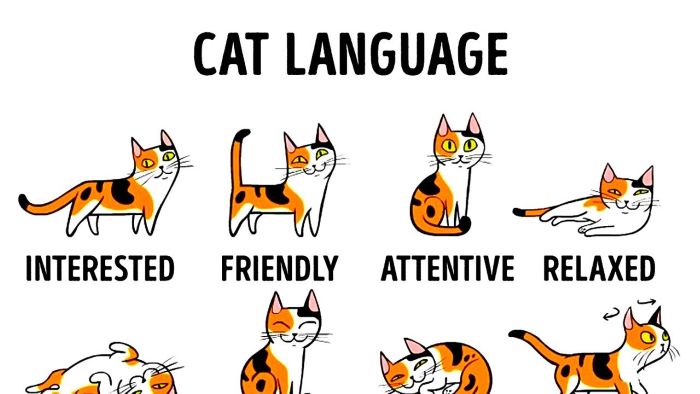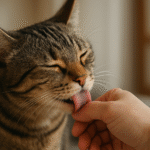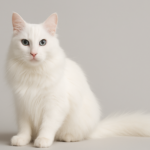Cats are generally solitary animals. Highly independent, they have developed subtle and complex ways of behaving and communicating that often send confusing messages to their owners. Cats do, however, have a range of other signals that you can learn to interpret.
Facial Expressions and Body Language
Your cat will give you signals using his ears, tail, whiskers, and eyes. Ears and whiskers usually work together. Normally, the ears are erect and facing forward and the whiskers are to the front or sides, showing that your cat is alert and interested.
When his ears are rotated back and flat and his whiskers are forward, he is feeling aggressive. Ears out to the sides and whiskers flat against the cheeks mean that your cat is scared.
Cats do not like eye contact, which is why your cat will often make for anyone in the room who ignores him: this is interpreted as friendly behavior. Once your cat is used to those around him, he will find eye contact less threatening.
Dilated pupils can mean he is interested and excited or fearful and aggressive, so look for other signals to read his behavior.
Body Posture
Your cat’s posture tells you one of two things: “go away” or “come closer.” Lying down, sitting in a relaxed manner, or coming toward you indicates that he is approachable.
A cat on his back exposing his belly is not being submissive like a dog: this is usually a fight posture that allows him to wield all his claws and teeth. If he is also rolling from side to side, you can assume that he is in a playful mood, but avoid touching his belly too much or you may get scratched or bitten.
Wiggling the rump is another sign that he is up for a play. When your cat is crouching—either looking sideways or with his tail wrapped around his body—he is looking for a chance to escape, pounce, or go on the offensive.
Smell and Touch
Cats have a superb sense of smell and use urine and scent to mark territory and leave messages for other cats. They head-rub to deposit scent in areas where they feel relaxed and spray urine where they feel threatened.
A cat that is not neutered will spray to warn other cats of his presence, threaten any rivals, and announce that he is ready to mate. If a neutered cat still sprays, he is probably feeling anxious so investigate what is triggering this behavior.
Cats also spread scent from glands on their cheeks, paws, and tail by rubbing them on surfaces or other cats. These scents mark territory and help cats to form social bonds.
Cats that live together will rub each other along the flanks or the head, creating a group scent that alerts them to the presence of strangers. Your cat will also rub the members of your family to mark you all as part of his “gang.”
Cats sniff nose-to-nose when they meet; unfamiliar cats end the encounter there, but friendly cats progress to rubbing heads or licking each other’s face or ears. Scratching is another way of leaving scent, as well as being a visual signal of a cat’s presence.
Cat Vocalizations
Wild cats are solitary, predatory animals that patrol a territory they regard as theirs. Consequently, most cat communications are designed to ward off intruders. Learning what the noises he makes mean will help you understand what he is trying to tell you.
Chief among cat noises are hissing, growling, miaowing, and purring. Hisses and growls—sometimes accompanied by a flash of teeth or show of claws—are warnings to usurpers trespassing on the cat’s territory or to humans who get too close.
Meows—rarely used between adult cats—are mainly a way for kittens to signal to their mother. Domestically, your cat will use meowing to announce his presence. Short and high-pitched chirps and squeaks usually signal excitement or a plea for something, but drawn-out and low-pitched sounds express displeasure or a demand.
Rapid, intense, and loud repeated sounds often signify anxiety. Long, drawn-out cries and shrieks indicate that the cat is in pain or fighting. Mating cats produce long wails known as caterwauls. Purring is usually a sound of contentment, but cats also purr as a way of comforting themselves when they are in pain or anxious.
 Cat begging for food
Cat begging for food





